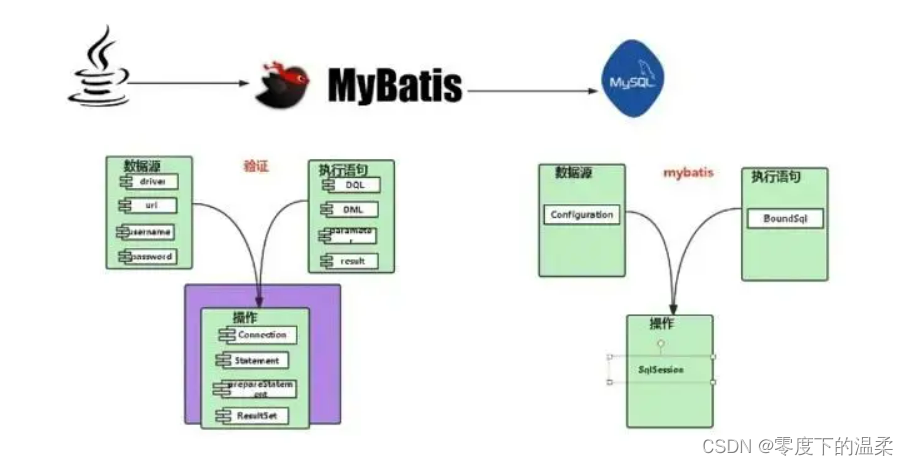java 培训 MyBatis 动态 SQL
Mybatis 框架的动态 SQL 技术是一种根据特定条件动态拼装 SQL 语句的功能,它存在的意义是为了解决拼接 SQL 语句字符串时的痛点问题。
1、if
if 标签可通过 test 属性的表达式进行判断,若表达式的结果为 true,则标签中的内容会执行;反之标签中的内容不会执行
<!--List<Emp> getEmpListByMoreTJ(Emp emp);-->
<select id="getEmpListByMoreTJ" resultType="Emp">
select * from t_emp where 1=1
<if test="ename != '' and ename != null">
and ename = #{ename}
</if>
<if test="age != '' and age != null">
and age = #{age}
</if>
<if test="sex != '' and sex != null">
and sex = #{sex}
</if>
</select>
2、where
<select id="getEmpListByMoreTJ2" resultType="Emp">
select * from t_emp
<where>
<if test="ename != '' and ename != null">
ename = #{ename}
</if>
<if test="age != '' and age != null">
and age = #{age}
</if>
<if test="sex != '' and sex != null">
and sex = #{sex}
</if>
</where>
</select>
where 和 if 一般结合使用:
a>若 where 标签中的 if 条件都不满足,则 where 标签没有任何功能,即不会添加 where 关键字
b>若 where 标签中的 if 条件满足,则 where 标签会自动添加 where 关键字,并将条件最前方多余的 and 去掉_java培训
注意:where 标签不能去掉条件最后多余的 and

3、trim
<select id="getEmpListByMoreTJ" resultType="Emp">
select * from t_emp
<trim prefix="where" suffixOverrides="and">
<if test="ename != '' and ename != null">
ename = #{ename} and
</if>
<if test="age != '' and age != null">
age = #{age} and
</if>
<if test="sex != '' and sex != null">
sex = #{sex}
</if>
</trim>
</select>
更多 Java –大数据 – 前端 – UI/UE - Android - 人工智能资料下载,可访问百度:尚硅谷官网(www.atguigu.com)
trim 用于去掉或添加标签中的内容_java视频
常用属性:
prefix:在 trim 标签中的内容的前面添加某些内容
prefixOverrides:在 trim 标签中的内容的前面去掉某些内容
suffix:在 trim 标签中的内容的后面添加某些内容
suffixOverrides:在 trim 标签中的内容的后面去掉某些内容
4、choose、when、otherwise
choose、when、otherwise 相当于 if...else if..else
<!--List<Emp> getEmpListByChoose(Emp emp);-->
<select id="getEmpListByChoose" resultType="Emp">
select <include refid="empColumns"></include> from t_emp
<where>
<choose>
<when test="ename != '' and ename != null">
ename = #{ename}
</when>
<when test="age != '' and age != null">
age = #{age}
</when>
<when test="sex != '' and sex != null">
sex = #{sex}
</when>
<when test="email != '' and email != null">
email = #{email}
</when>
</choose>
</where>
</select>
5、foreach
<!--int insertMoreEmp(List<Emp> emps);-->
<insert id="insertMoreEmp">
insert into t_emp values
<foreach collection="emps" item="emp" separator=",">
(null,#{emp.ename},#{emp.age},#{emp.sex},#{emp.email},null)
</foreach>
</insert>
<!--int deleteMoreByArray(int[] eids);-->
<delete id="deleteMoreByArray">
delete from t_emp where
<foreach collection="eids" item="eid" separator="or">
eid = #{eid}
</foreach>
</delete>
<!--int deleteMoreByArray(int[] eids);-->
<delete id="deleteMoreByArray">
delete from t_emp where eid in
<foreach collection="eids" item="eid" separator="," open="(" close=")">
#{eid}
</foreach>
</delete>
属性:
collection:设置要循环的数组或集合
item:表示集合或数组中的每一个数据
separator:设置循环体之间的分隔符
open:设置 foreach 标签中的内容的开始符
close:设置 foreach 标签中的内容的结束符
6、SQL 片段
sql 片段,可以记录一段公共 sql 片段,在使用的地方通过 include 标签进行引入
<sql id="empColumns">
eid,ename,age,sex,did
</sql>
select <include refid="empColumns"></include> from t_emp











评论